Changing time zones can be tough, especially with a little one in tow. These tips will help you survive toddler jet lag so you can make the most of your family vacation.
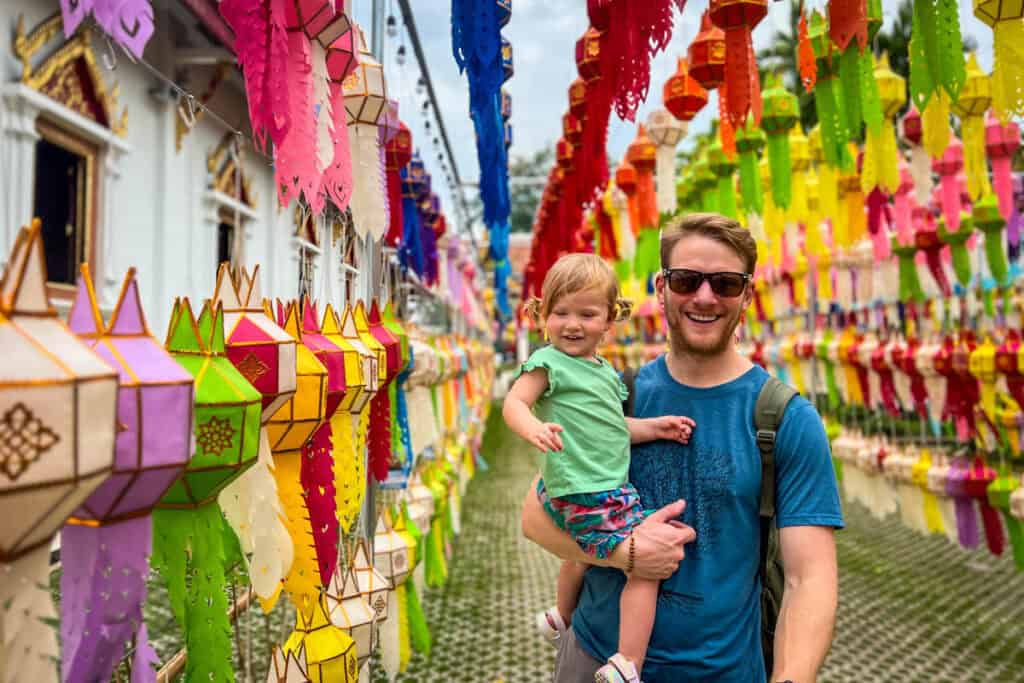
One of the most common questions we get about traveling as a family is how we deal with jet lag with a toddler.
This is a somewhat complicated question to answer because:
- All children are different, and each little one will react differently to shifting time zones.
- Things will vary quite a bit depending on the time difference; e.g. crossing two time zones on a weekend trip to NYC versus traveling across 17 time zones on a 3-week trip in Japan.
After several trips across many time zones with our daughter, we have learned a lot about how to handle time zone changes and jet lag with a toddler.
This article is based on our experience and is full of tips that have worked for us, personally. Pick and choose which ones speak to you and hopefully you’ll find some strategies that work for your family.
Toddler Jet Lag Guide
Our experience
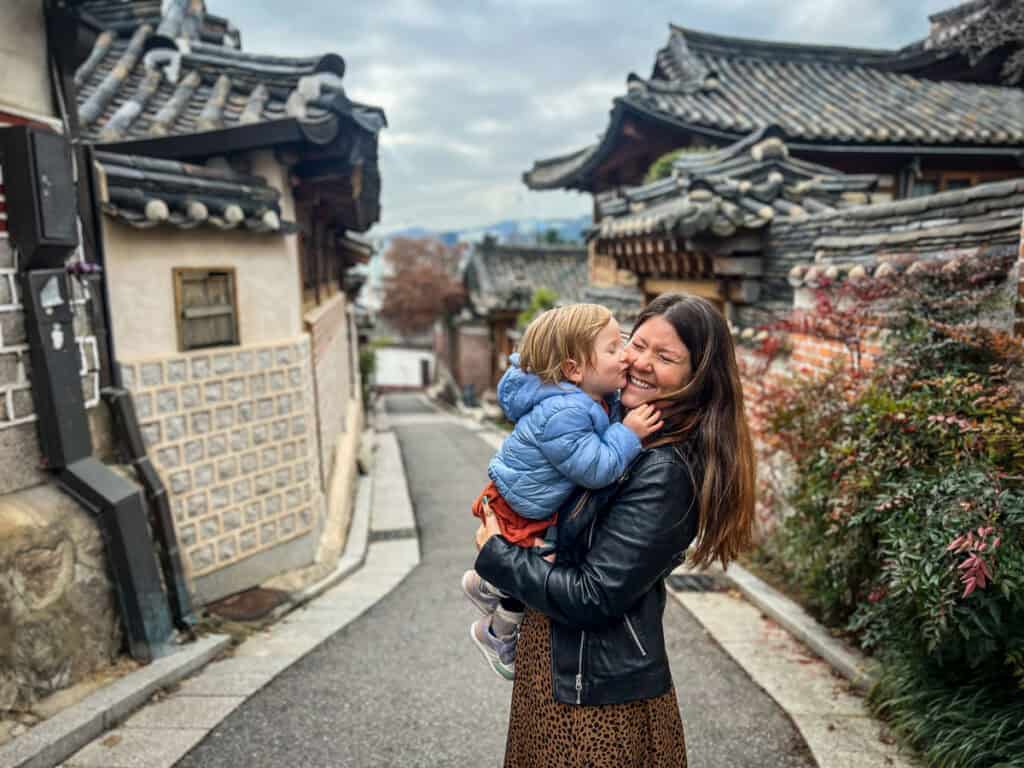
In her first 3 years of life, we took our daughter, Juniper, on more than 60 flights around the world, traveling in 9 different time zones. Here are a few examples of time differences she’s experienced flying from our home in Bend, Oregon:
Safe to say, we’ve had a lot of experience dealing with jet lag, and we’ve learned a few tricks that have been super helpful for our family.
→ Psst! You can read our full story and browse all our Family Travel articles here.
Tips for dealing with toddler jet lag
In this article, we’re sharing strategies that have worked for us, personally. We hope you take the advice that resonates with you and feel empowered to plan and execute your dream family trips!
→ Related: We have another whole guide full of tips to help you to combat jet lag, too!
1. Determine if you even need to adjust time zones

If you’re shifting just 1-3 hours from your home time zone, you may not even need to adjust at all.
If it’s just a short trip, this can work really well and will also cut down on the adjustment when you go back home.
While you’ll want to aim for the same amount of sleep they typically get at home, there’s no rule that says you have to abide by their normal bedtime hour.
Practical example: Let’s say you are traveling from Seattle to NYC. This means you will be 3 hours later than at home. Perhaps instead of a 7 p.m. bedtime, you allow your little one to stay on their normal schedule and go to bed at 10 p.m. which will allow you to have extra time to explore the city in the evening and dinner at a decent time. This will also mean later wake-ups, which is always nice on vacation.
2. Give yourself 3 buffer days
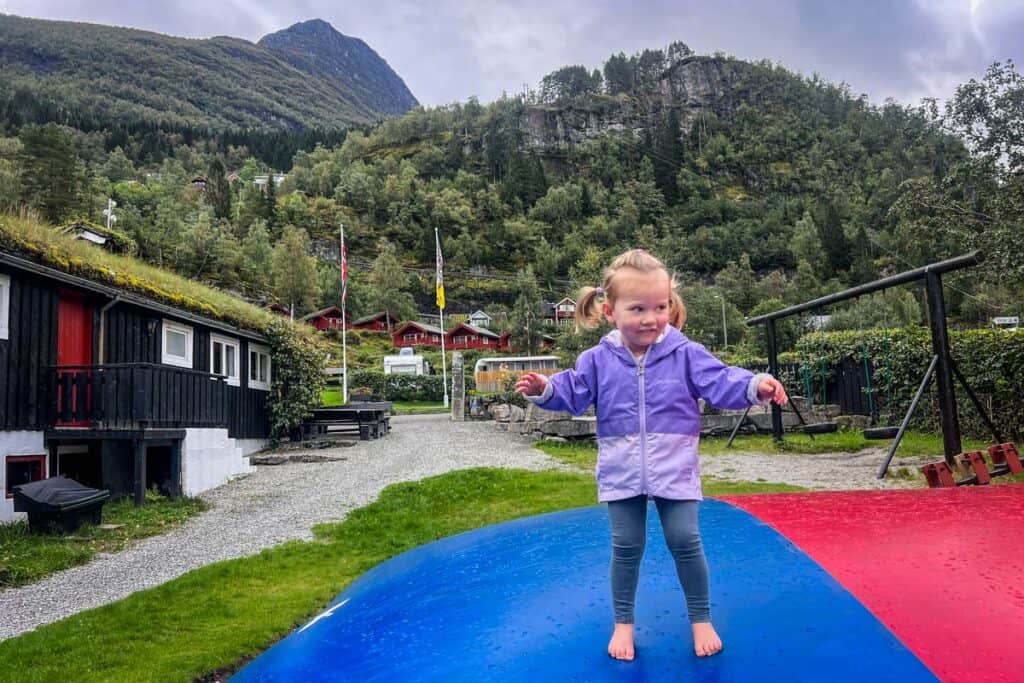
If you’ll be changing several time zones (5+), I’d recommend giving yourself 3-ish days that are somewhat low-key.
This will alleviate any pressure and will allow you and your little one to rest up after a long travel day.
This doesn’t mean you can’t make any plans for the first few days (you definitely should!), but I’d recommend sticking to activities that aren’t super time consuming or require a lot of energy. I’d also recommend saving your bucket list experiences for once you’ve all had a bit of time to adjust.
Insider tip: You may even want to splurge on a nice accommodation those first few days so you can get a really good rest and take advantage of amenities, like a pool. This will get you outside and moving, but is a low-pressure activity.
Psst! We have created the perfect schedule to get you through the first 3 days of your trip. Jump down to see it.
3. Be prepared for Day 3

Speaking from our own personal experience, there is just something about Day 3 on a trip when you’ve crossed multiple time zones…
Day 1: Personally, we find that the day we land in our destination is tiring because the act of flying with a child is, well, a lot. So shifting time zones doesn’t really even come into play just yet. We’re just usually pretty zonked by the time we reach our destination.
Ideally, we try to eat dinner at the local time and stay up until a reasonable bedtime hour before turning in.
Day 2: After a good night’s sleep on Day 1 coupled with the excitement of being in a new place, we’re usually feeling pretty good to go on Day 2. But don’t let that fool you…
Day 3: This is typically the day that we notice the time difference (and our toddler does as well). But, if we are prepared for this, we can usually power through and make it to a decent bed time.
In our experience, after Day 3, ourselves and our toddler are usually pretty much adjusted to our destination’s time zone.
4. Eat at the local meal times

Try to adjust to the local meal times as soon as possible as this will be very helpful in getting their bodies adjusted overall.
Plus, a full belly will help your little one stay asleep through the night.
5. Pay attention to what they’re eating

In addition to eating at typical meal times, ensure your little one is having well-balanced meals with plenty of protein, healthy fats, and carbs.
During the first few days, it can be a good idea to stick to more familiar foods so that mealtime is as easy as possible. It’s also good to have some of their favorite (healthy) snacks on hand so you can avoid any hanger.
On that note, do your best to limit the amount of sugary treats, which will lead to inevitable sugar crashes.
→ Related: We made a list of our favorite travel snacks for babies and toddlers that are healthy, convenient, and mess-free.
6. Keep hydrated
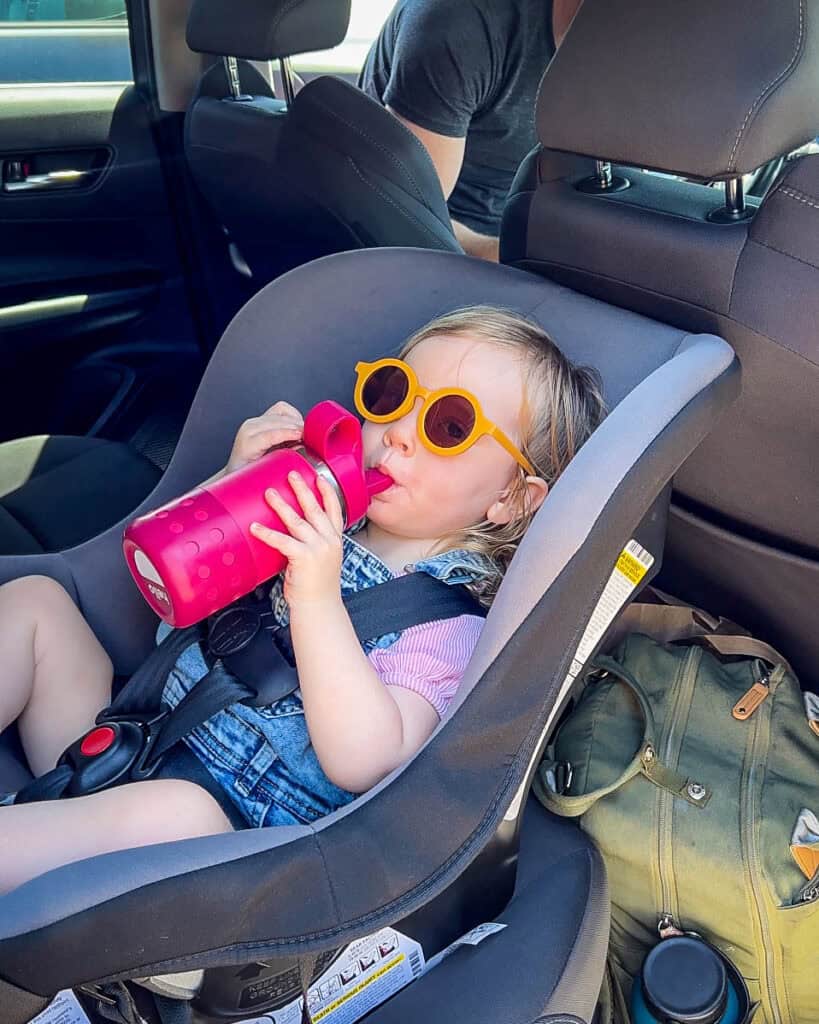
After a long haul flight when your little one’s body is adjusting to an entirely new time zone and environment, it’s especially important to make sure they’re staying hydrated.
Keep a bottle of water with them at all times and remind them to keep drinking it.
7. Take care of yourself, too
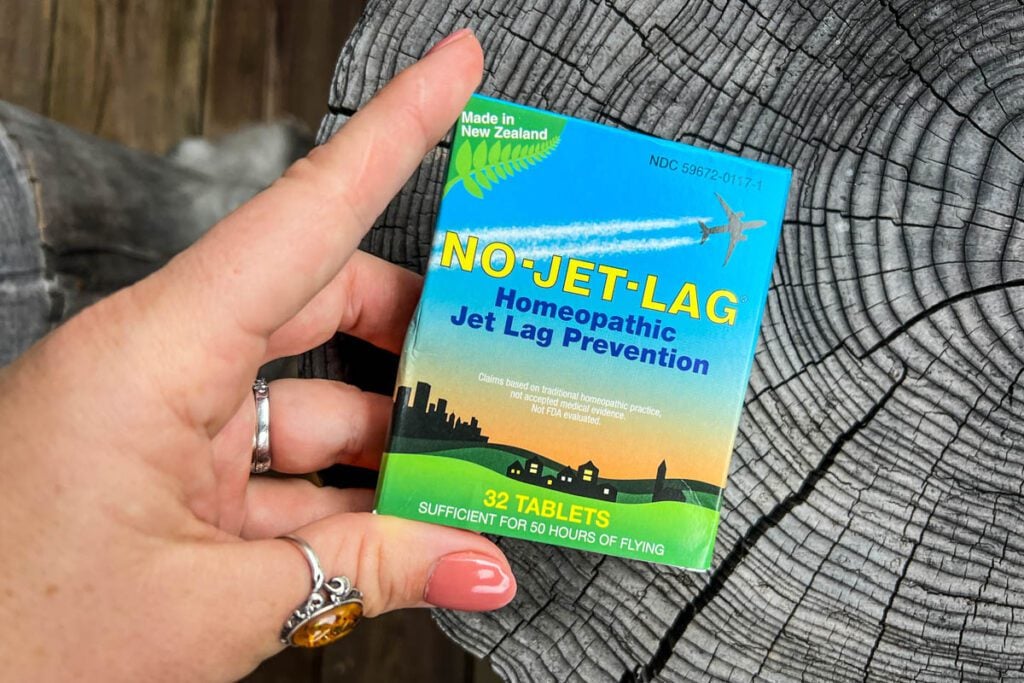
While you might be most concerned about how your child will handle jet lag, don’t forget about yourself. If you are sleepy and out of sorts, it’ll be especially hard to care for your little one.
- Stay hydrated. Also, avoid alcohol for the first couple of days if possible.
- Use caffeine to your advantage. If you’re a coffee drinker, try your best to avoid caffeine after 2 p.m. But if you’re groggy when you wake up, go for a nice, strong cup of Joe!
- We like these homeopathic “No Jet Lag” pills when we’re traveling through many time zones.
- Avoid screens after dark on your first few days to help your circadian rhythm adjust.
- Get outside and move! This is helpful for all members of your family.
- Keep reading our full list of tips for combatting jet lag!
8. Recreate their bedtime routine
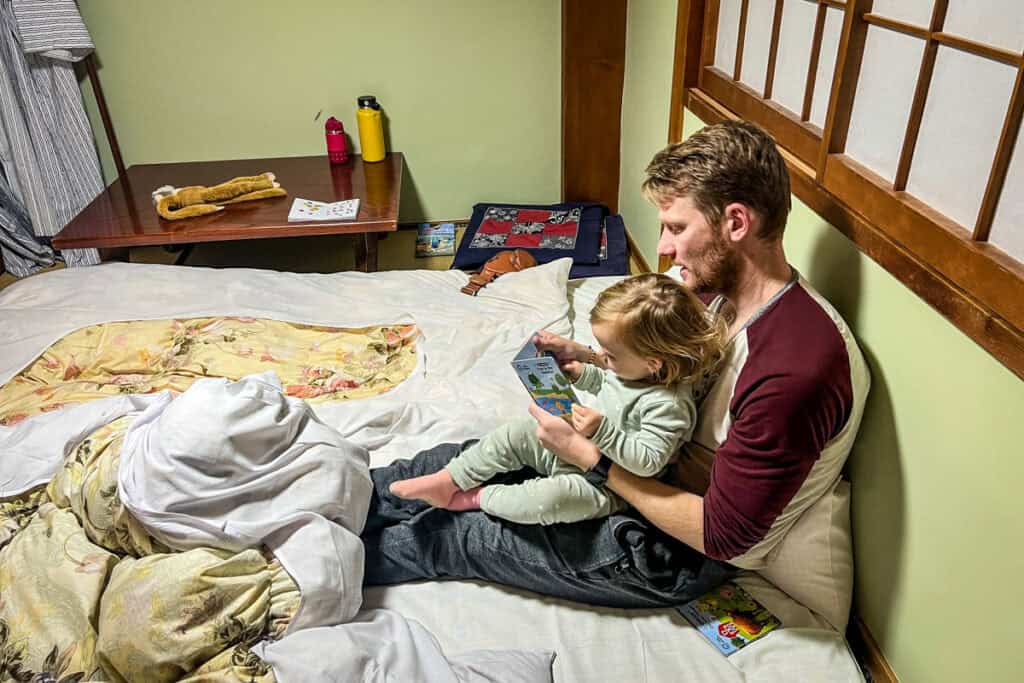
We are really big fans of creating bedtime routines that can be replicated anywhere in the world. This helps cue our toddler that it’s time to start winding down, even if their internal clock isn’t quite shifted yet.
Do the things that you normally do to signal bed time:
- take a bath
- change into jammies
- brush teeth
- tell stories
- sing a lullaby
Or whatever else is part of your bedtime routine.
9. Pack sleep essentials
Bring things from home that will help with this routine and make your child feel comfortable:
- favorite (lightweight) book
- sleepsack for younger children or cozy pjs for toddlers
- favorite stuffed animal or blanket
- travel sound machine
- travel-friendly night light
- travel blackout curtains
Psst! Download our complete packing list for traveling with a little one so you don’t forget anything! Click the image below to get your FREE printable checklist.

10. Make the room dark
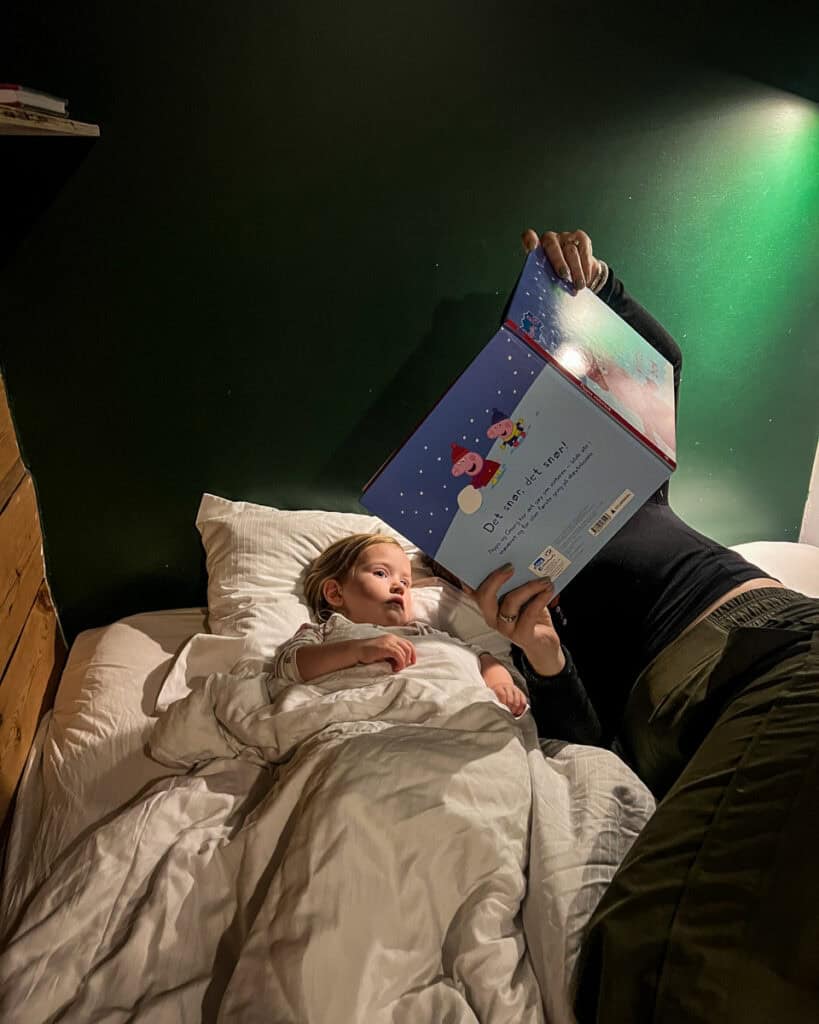
Whether you have travel blackout curtains or not, it is important to make sure your space is as dark as possible to minimize the chance of a really early wake up.
Look at photos of your hotel room before your trip to determine if you should bring your own blackout curtains.
Our experience:
Personally, we don’t travel with blackout curtains because we don’t want to have to rely on them, and our daughter’s room at home isn’t totally blacked out so it’s not something she personally needs in order to sleep. However, if your child does best in a totally dark room, this could be very helpful.
We’ve only had one Airbnb where we had an issue with it not being able to make it dark enough. In that case, travel blackout curtains wouldn’t have helped at all because they were floor to ceiling windows with sheer curtains (and to top it off, we were next to a busy street). We ended up switching accommodation!
→ Related: Be sure to read these tips for booking accommodations with a little one (and getting a great night’s sleep!).
11. Consider using a sleep aid
This may be a controversial one, but a child-friendly form of melatonin could be a huge help on those first few nights if your toddler isn’t at all tired.
Personally, we didn’t try this until our daughter was almost 3 years old, and we try to only use it sparingly in circumstances when we all really need the sleep. I’ll be honest, it works super well.
If this isn’t something you’re comfortable with, ignore this tip. Magnesium isn’t quite as impactful in our experience, but could be another option to consider.
12. Be prepared for a middle of the night wake up
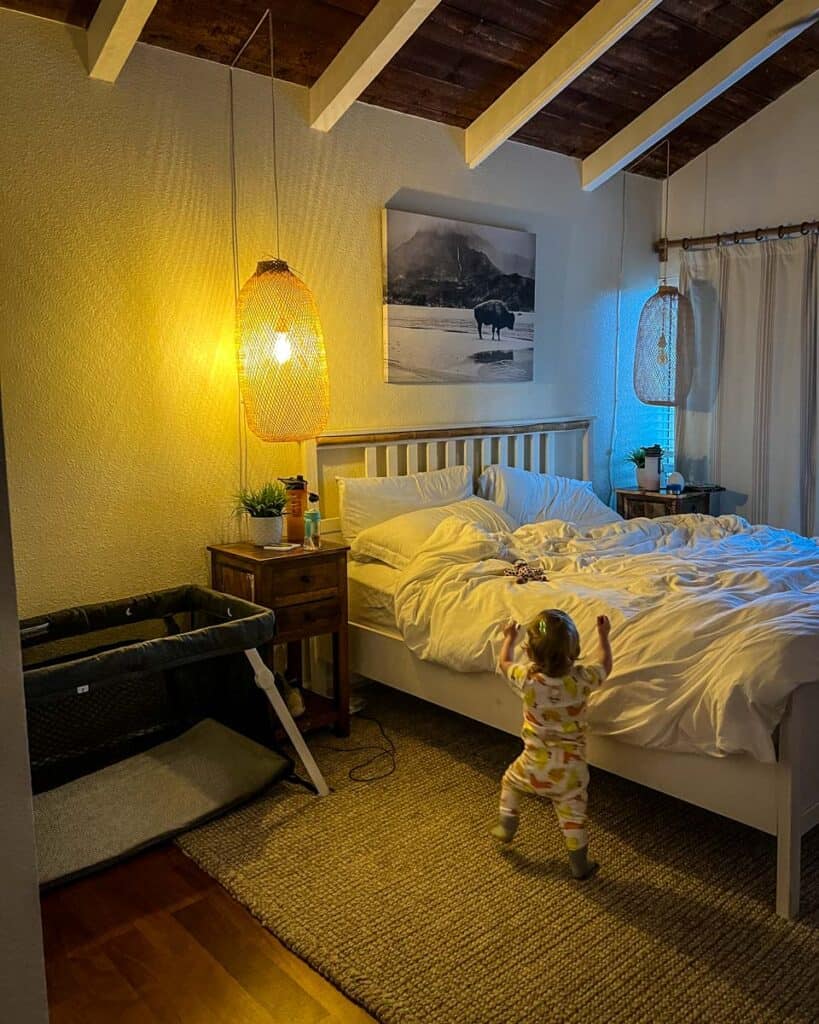
Your toddler may very well wake up during the night on those first few days.
If your toddler wakes up in the middle of the night during the first couple of nights, trade off duties with your travel partner (if you have one) so you aren’t all awake.
- Keep the room dark.
- Use a soft voice.
- Tell a bedtime story or sing a lullaby.
- Offer a snack with protein, like plain yogurt, string cheese, or a beef stick. (Avoid sugary snacks.)
Be prepared for this, discuss who will take the first shift, and keep those foods handy.
Your child may surprise you and not wake up, but at least you’ll be mentally prepared if they do.
13. Keep moving

If you arrive at your destination midday, it can be tempting to just turn in and lounge in your hotel room. If you need a reset, go for it; but I’d encourage you to get the whole family outside and moving as soon as you can.
This goes for Day 2 as well. Even if you wake up groggy, get out there and get everyone moving. Walking to a nearby park can be a great way to entice your toddler to get some movement in.
14. Understand the science behind jet lag
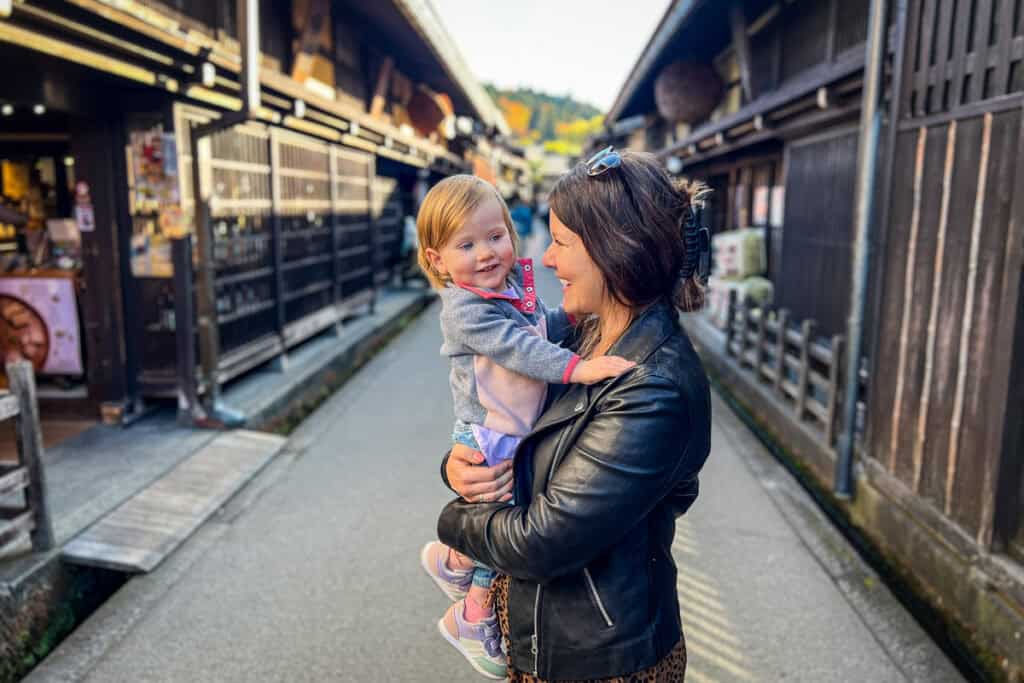
This article dives deep into the details (some of it is a little dense, but it is also pretty fascinating).
It goes over exactly when to expose your toddler to daylight (according to your home time zone) and when to shift into dark mode.
If you will be changing time zones with your toddler for the first time, I’d recommend reading that article and doing a little math so that you’re prepared. But again, don’t stress too much about it because your toddler may do just fine without hyperfixating on daylight hours.
Our experience: To be honest, I usually just follow the tips on this list and use my intuition to get myself and my toddler adjusted to new time zones. I don’t stress too much about it, and it has never been a huge issue for our family.
That said, some little ones may struggle more than others with this type of adjustment, so it is a good idea to learn a bit more about the science behind jet lag.
15. Use daylight (or darkness) to your advantage
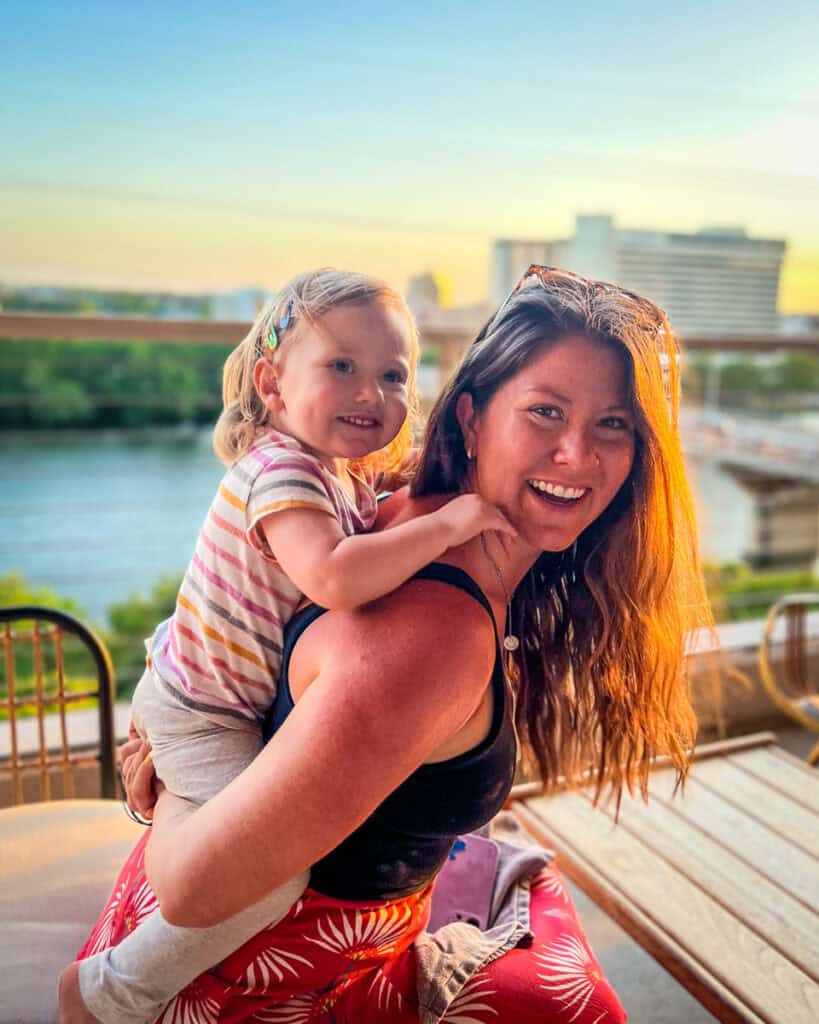
Opening the windows during daylight hours—and better yet, getting outside!—will help you and your child start adjusting to the new time zone.
Likewise, in the evening hours, try avoiding bright lights and make your sleeping space dark to try to get on your new bedtime schedule.
The article linked in the tip above goes into the science behind how light and darkness can impact your child’s sleepiness level.
According to that article, exposing your child to daylight before their internal clock is ready can actually make jet lag worse, so I think it’s worth taking a look at, especially if you have a feeling your child might have a tough time adjusting.
16. Try not to sleep in too late

On those first few days, try your best to allow everyone in your family to get a full 8-10 hours of sleep. But don’t let it get much past that.
Set your alarm and wake your little one up so you can start getting adjusted.
Depending on what time you went to sleep on your first night, you may choose to let everyone sleep in on Day 2. But after that, aim to wake up no later than 8 a.m. (or a time that is relatively similar to what you do at home).
This goes for naps too.
On those first days, it’s fine to let them nap a little longer than usual, but we try to wake our daughter up if it’s more than 30 minutes past her normal nap length.
This will help them adjust much more quickly.
17. Avoid screens on the first few days
If possible, limit (or completely avoid) screens on the first days, as this can impact your toddler’s circadian rhythm.
18. Adjust your expectations

Know that you likely won’t be able to tick a bunch of things off your vacation bucket list in those first days.
Keep your expectations low for how much you’ll be able to do, and who knows – your little one may just surprise you!
19. Don’t get too stressed about it

I’ve talked to a lot of parents who are hesitant to travel with their kids because of jet lag, and my advice is this:
Be prepared (which you’re already doing by reading this article), but don’t let it stress you out too much.
Remember, jet lag is temporary and will likely only impact the first few days of your trip.
Ideal schedule for your first 3 days

Use this outline as a guide on how to handle your first few days in a new time zone to help all family members adjust.
Day 1
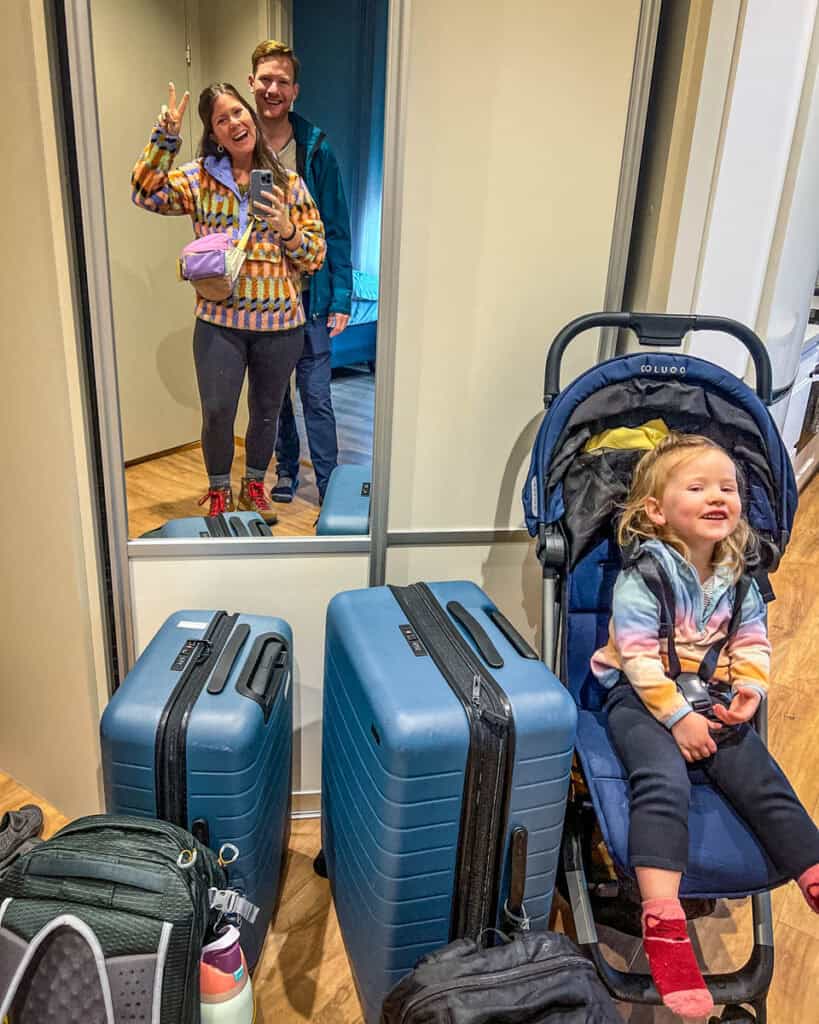
If you land during the day:
- Check into your hotel and freshen up with a shower.
- Try your best not to rest too much yourself. A quick nap can be helpful in some cases, but set an alarm.
- Allow your child to nap as usual, or even 30 minutes longer, but be sure to wake them up before too long otherwise they will have a hard time going to sleep tonight.
- If possible, get out and walk in the daylight. Movement will help you stay awake.
- Try your best to avoid caffeine after 2 p.m. so that your body naturally gets tired at nighttime.
- Eat meals in accordance with your new time zone (as best you can).
- Try to make sure everyone has enough food for dinner, then head to your hotel.
- Do your child’s nighttime routine and try to get them down at a “reasonable” time for bedtime in your destination. (Not too early, not too late.)
- Likely after a travel day, you’ll all be exhausted and going to sleep won’t be too difficult.
If you land at night:
- Try to keep your child awake for the final few hours of your journey. Have interactive toys and healthy snacks ready to keep them entertained.
- Have a solid dinner if possible (on the plane, at the airport, or room service), and settle in at your hotel.
- Tonight is a good night to give your little one a bath and follow your normal bedtime routine.
Be prepared: Your child may wake up tonight. Have some healthy snacks handy, which may be all they need. Read tip #12 for more ideas of what to do if they wake.
Day 2

Don’t have any “bucket list” plans today or things you can’t miss. But have a few low-stress activities in mind so that you can all stay active and awake.
- Sleep in a bit today, but not too much. You want to be well-rested (especially if you had wake-ups last night), but you also want to start adjusting your daytime to your new location.
- Grab a hearty breakfast. It can be a good idea to have a place in mind in advance so you don’t have to search.
- If you drink caffeine, this is a good time to have a coffee! But don’t forget to hydrate too!
- Be sure your child is fed and hydrated.
- Get outside and move. Bring your child to a playground or a pool to get them excited and active. This will help their bodies adjust to this new daytime.
- Try to get them on their normal nap schedule. If they nap in the middle of the day, try to set the scene (sound machine, go back to your hotel, recline the stroller) so that it’s easier for them to fall asleep.
- Wake them up from their nap if it goes longer than usual.
- Have dinner at what is considered a “normal” time in your destination. If your child isn’t super hungry, don’t stress too much. But make sure you have some healthy options for later when they get hungry.
- Recreate your child’s normal bedtime routine as best you can.
Day 3
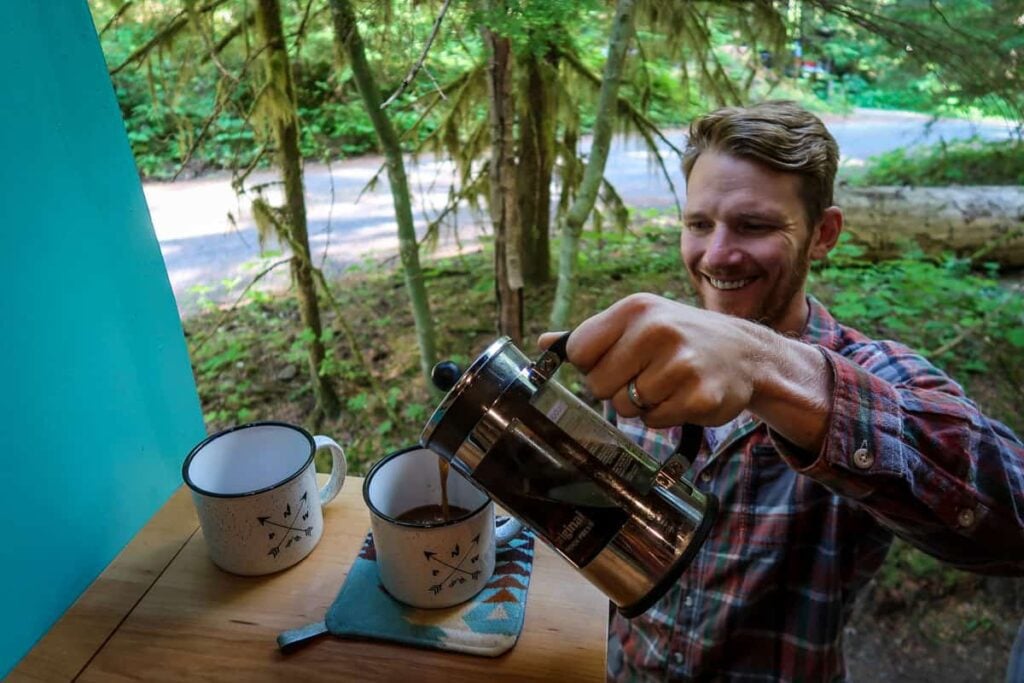
For some reason, this day is always the hardest for us. Be prepared for this day to be a little rough, and don’t plan any intense activities or bucket list experiences.
The good news is that in our experience, we find we’re usually pretty well-adjusted after Day 3.
- Set your alarm for the time you’d like to wake up through the rest of the trip. Make sure everyone is up.
- Have a morning coffee (if you drink it) and breakfast.
- Hydrate!
- Get outside in the daylight and move, if possible.
- Your toddler should nap as normal, not any longer.
- Plan some light activities throughout the day.
- Have dinner and bedtime on your ideal schedule.
- We usually find we sleep pretty well this night because we’re all tired from the change.
Day 4+
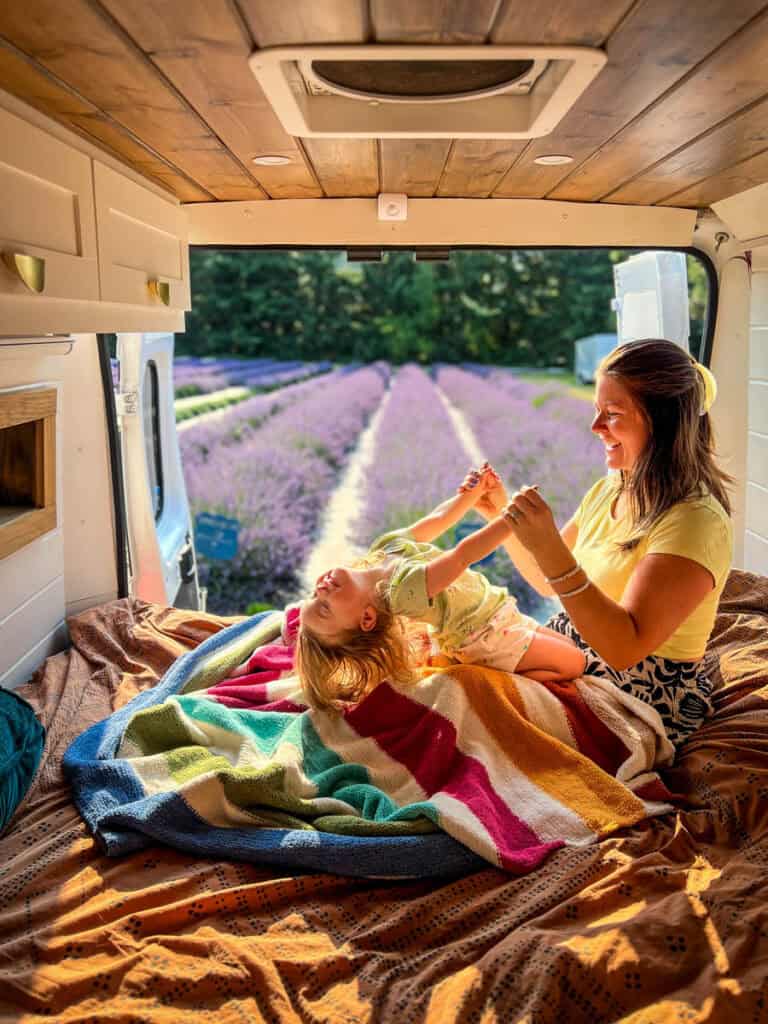
While you may not be 100% adjusted by Day 4, you should be pretty close. Waking and going to bed at normal hours should be pretty easy for both you and your toddler.
Be sure to set your alarms in the morning to avoid oversleeping, and stick to a bedtime routine to keep your child on track.
If your little one is still having trouble adjusting, I’d recommend reading up on the science behind jet lag in this article to make any adjustments needed.
What about jet lag with babies?
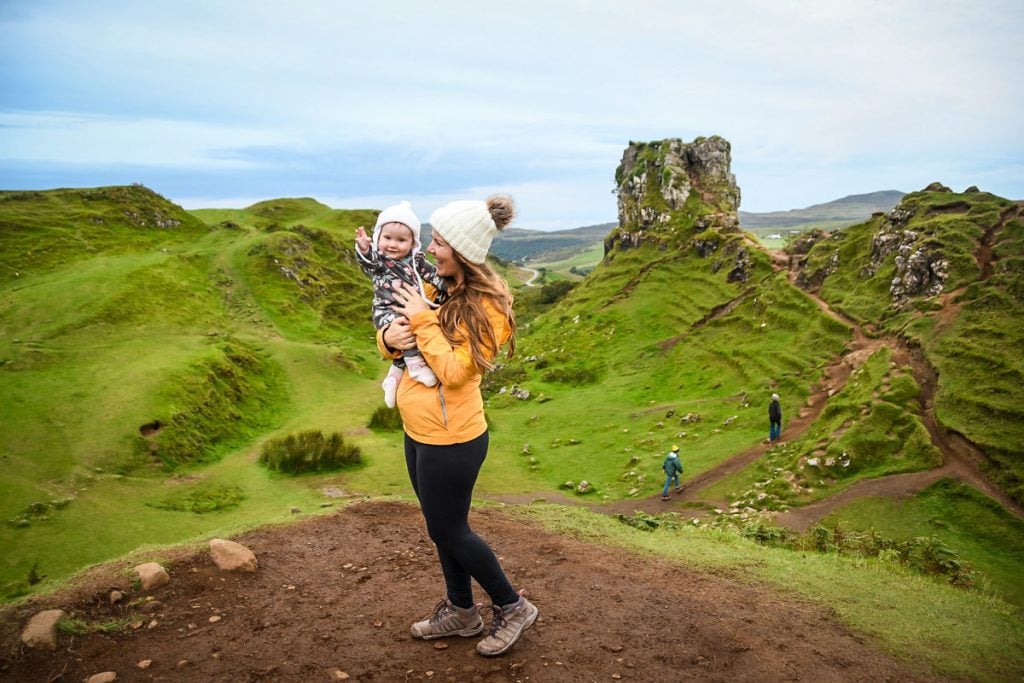
Babies who don’t have a sleep schedule already established will actually be pretty easy to adjust to a new time zone. The trickier part is when they are toddlers with well-established routines.
That said, these tips should be very helpful in getting your whole family adjusted to a new time zone.
Want more advice for traveling as a family?
WWe have lots of resources on traveling with children, from newborns to toddlers. Check out our Family Travel Guide for all the answers to your most burning questions, or read some of our favorite articles below!
- Practical Family Travel Tips: The ultimate guide to traveling with a baby or a toddler
- Flying with a Baby: Tried-and-true tips to prepare you for the flight
- Hotel or Airbnb with a Baby: Read this before you book any accommodations!
- Travel Snacks for Toddlers & Babies: Easy + healthy snacks to avoid a hangry child (or parent)
- Best Travel Toys for Toddlers & Babies: Tested + parent-approved toys that will keep your little one entertained (and won’t take up too much luggage space)
- Encouraging Family Travel Tips: Heartfelt advice to boost your confidence!
Don’t forget to download our FREE printable packing list for traveling with a baby! Click the image below to get yours.

Save these tips on Pinterest so you don’t lose them!


We want to hear from you!
We hope these tips for dealing with toddler jet lag are helpful!
What advice would you add? Any travel hacks that have helped you? What questions or concerns do you still have?
Note: Please be respectful with your comments. Remember, we are sharing tips that have personally worked for us. This doesn’t mean they will work for everyone.
